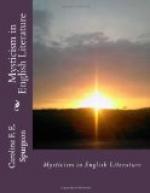We have seen that the earliest mystical thought came into this country by way of the writings of “Dionysius” and of the Victorines (Hugh and Richard of St Victor), and it is this type of thought and belief cast into the mould of the Catholic Church that we find mainly in the little group of early English mystics, whose writings date from the middle of the thirteenth to the beginning of the fifteenth century.[52]
These early Catholic mystics are interesting from a psychological point of view, and they are often subtle exponents of the deepest mystical truths and teachings, and in some cases this is combined with great literary power and beauty.
One of the earliest examples of this thought in English literature is the tender and charming lyric by Thomas de Hales, written probably before 1240. Here is perhaps the first expression in our poetry of passionate yearning of the soul towards Christ as her true lover, and of the joy of mystic union with Him. A maid of Christ, says the poet, has begged him to “wurche a luve ron” (make a love-song), which he does; and points out to her that this world’s love is false and fickle, and that worldly lovers shall pass away like a wind’s blast.
Hwer is Paris and Heleyne
That weren so
bright and feyre on bleo:
Amadas, Tristram and Dideyne
Yseude and alle
theo:
Ector with his scharpe meyne
And Cesar riche
of wor[l]des feo?
Heo beoth iglyden ut of the
reyne,
So the schef is
of the cleo.
As the corn from the hill-side, Paris and Helen and all bright lovers have passed away, and it is as if they had never lived.
But, maid, if you want a lover, he continues, I can direct you to one, the fairest, truest, and richest in the whole world. Henry, King of England, is his vassal, and to thee, maid, this lover sends a message and desires to know thee.
Mayde to the he send his sonde
And wilneth for to beo the
cuth.
And so the poem goes on to express in simple terms of earthly love, the passionate delight and joy and peace of the soul in attaining to union with her God, in whose dwelling is perfect bliss and safety.
This poem is a delicate example of what is called “erotic mysticism,” that is the love and attraction of the soul for God, and of God for the soul, expressed in the terms of the love between man and woman. It is a type of expression characteristic of the great mystics of the Catholic Church, especially in the Middle Ages,[53] and we find a good deal of it in our earliest mystical writers. One of the most charming examples of it other than this lyric, is the chapter “Of Love” in the Ancren Riwle, or Rule for Anchoresses, written probably early in the thirteenth century. An account is there given, quite unsurpassed for delicate beauty, of the wooing of the soul by God.[54] On the whole, however, this type of mysticism is rare in England,




